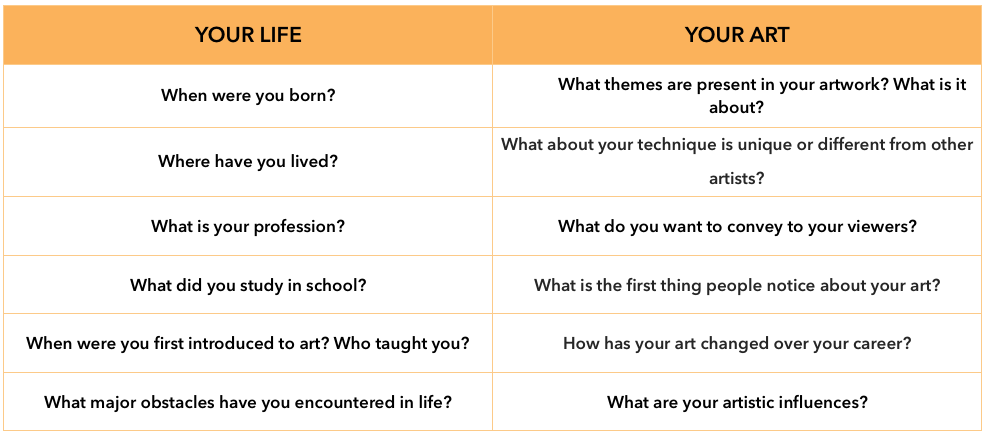Writing an Artist Biography vs. Statement: Why You Need Both
Written by Joely Rogers
“Why bother with an artist biography if I already have an artist statement?” you may ask. “After all, shouldn’t the focus be on my art?” Great questions. However, although an artist statement describes your art, an artist biography lets you to talk about yourself.
People are naturally curious about artists. They may wonder things like: where do you live, are you self-taught or academically trained, have you always been an artist or did you transition from a different career, do you have collectors? All these wonderings create the perfect opportunity to engage with your audience by sharing your story, your way.
What is An Artist Biography?
In general, an artist biography is like a typical biography. It should talk about your life — your history, education, work, etc. The difference is that an artist bio should focus on your artistic life rather than strictly your personal background.
What Voice Should it Be Written In?
Writing in first person — using “I” or “me” statements — conveys a more intimate, casual tone. Some artists prefer the third person, as it allows you to describe your experience and talents in a way that feels objective. With this approach, you would use your full name on first reference followed by your first or last name on subsequent references, along with “he,” “she” or “they” pronouns. Go with whichever voice feels most like you.
How Long Should the Biography Be?
One to three paragraphs are typical for an artist biography. Think tight, powerful sentences packed with information, and also loaded with keywords if you are writing for your website.
What Should An Artist Biography Include?
• Your current location and/or birthplace.
• The type of artist you are: photographer, painter, illustrator, sculptor, collage or fiber artist, performance, digital, etc.
• A basic description of your artwork and process. For example, “He takes macroscopic images of flower parts to share their intricate and colorful details.”
• Your education, training and apprenticeships. If you are self-taught, say it!
• A simplified description of your exhibition history.
• Where or how you sell your art, including all appropriate links if this information will be displayed online.
• If you have a blog to showcase or an Instagram account, provide the link for an online bio or make the URL clear in print.
What Should it Omit?
• Your address and phone number. If you want walk-in customers, put this under your contact information in a separate area.
• Outside quotes or opinions about your art. Put these under a special section for testimonials.
• Detailed information about your exhibition and educational history. Put these on your Artist CV/Resume.
Helpful Tips When Writing an Artist Biography
• Be brief. Be concise. Get to the point.
• Use simple language. How would you tell your story to child or a non-artistic person?
• Be honest and don’t be embarrassed about your past or afraid of using humor. Tell your story in a way that feels authentic to you.
Get it Done: A Journal Exercise
If you’re not sure where to begin with your artist biography, here are a few prompts to get you going:
• Where do you currently live? Where were you born? How have these places influenced your artwork?
• What kind of artist are you? Examples of general categories: photographer, painter, illustrator, calligrapher, sculptor, fiber artist, watercolorist, etc.
• How would you describe your art? What do you make?
• Are you self-taught or do you have academic training? Have you studied or apprenticed with someone?
• Do you teach classes or workshops?
• Do you write about your art, or art in general? If so, where?
• Where have you exhibited?
• Do you have collectors or are you in any collections?
• If you sell your art, where or how do you sell it?
My Artist Biography As an Example
This is my most current artist biography. It’s written in third person. Unlike my artist statement (shown in my post How to Write an Artist Statement), which I consider a fluid document, my own bio right now is fairly static. That will change, though, if I move, switch mediums or interests, obtain another degree or more training, take on a different type of artistic role (like teaching or writing for a publication), or if get more actively focused on selling my art again.
Joely C. Rogers is a North Carolina-based food illustrator and artist who is passionate about showing the interconnection between food and culture. Her artwork depicts both the beauty and uses of various foods and ingredients. She has graduate training in storytelling and writes about her artistic and culinary explorations on her blog, Cafe Joely.
Joely also has extensive knowledge of picture framing and image display. Along with her husband, Mark Rogers, she co-owns Frame Destination, an online picture frame company for DIY framers. She writes about the marketing, display, and selling of art on Frame Destination’s blog.
Happy writing!
I hope you’re inspired to pen a first draft of your artist biography. Your customers — and prospective admirers — will be delighted by this inside peek into who you are as an artist.













